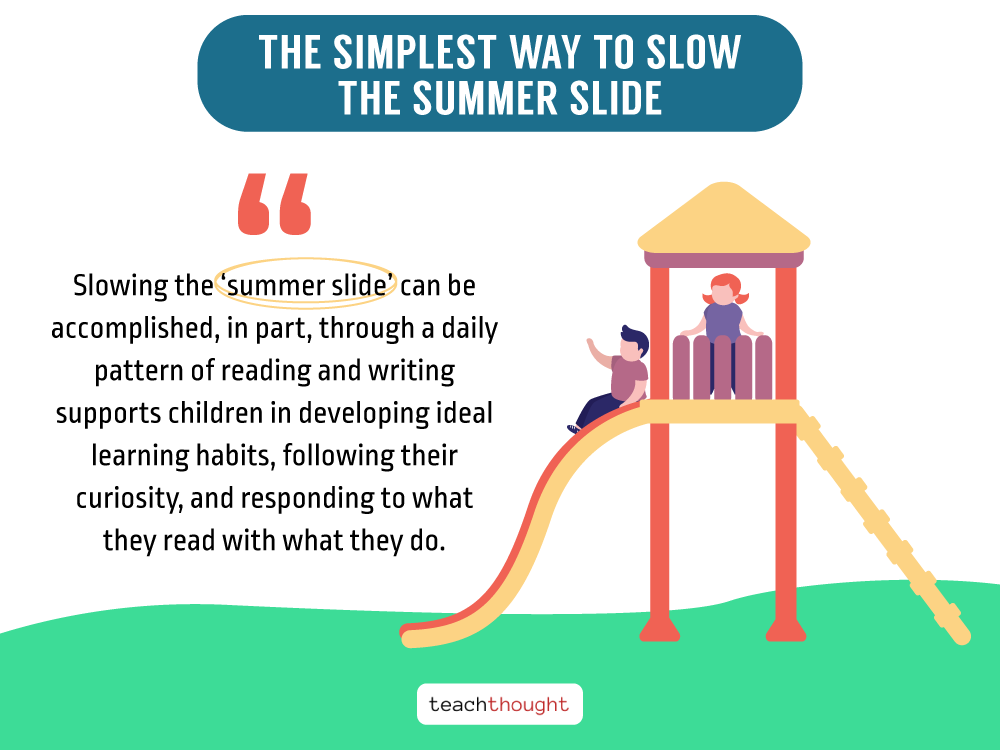
What Is The Best Way To Slow The Summer Slide?
by Terry Heick
Like every year, there’s a lot of dialogue right now about the dreaded summer slide.
Of course, this year is different than any in recent memory, and so the whole context of it changes. These arguments about how to slow the ‘summer slide’ usually include scary statistics, technology layers, and socioeconomic concerns.
This is a topic that could be looked at from a cultural, socioeconomic, economic, educational, parental, technological, or even philosophical perspective. Students learning at school and not learning at home is a complicated issue that begs a lot of questions:
Why are they not learning at home?
What do we mean by learning–learning what?
Who decides what’s worth understanding?
Why is there not more continuity between schools and communities?
If they’re not learning at home, what are they doing?
Can technology play a role here?
What are the equity and access concerns that aren’t as simple to untangle?
And so on.
This was a post we started as a collection of resources to slow the summer slide but it occurred to us that the most powerful way to ‘keep the learning going’ isn’t just a matter of tools and content. Summer is a time of heat, chaos, vacations, and children scattered throughout neighborhoods. Slowing the summer slide is more about habits and workflow than anything else.
This suggests a simpler approach–something manageable, not necessarily technology-based, and student–well, child driven: A daily pattern of reading and writing. Find something worth reading, read it, and then write about it.
Where does the reading coming from? If there’s technology access, setting up an RSS feed with an app like feedly or flipboard is simple. Add a variety of math, science, social studies, and related content to an RSS feed like feedly or a social media-based news feed, and have the child skim their feed, pick an article, and respond to it in writing on a daily basis. Every morning at 10 a.m. for an hour. Or whenever, for however long. The point is, they have a steady stream of reading content to sift through and read on a daily basis. It can also be a newspaper, magazines, or stack of books from the local library.
Where does the writing come from? For persistent prompts, use power verbs from any learning taxonomy. Critique. Evaluate. Document. Analyze. Defend. You could also have the students respond on their own–self-select a topic or angle. Free-write. Extend what they read by drafting a follow-up. So many options here.
Oftentimes, slowing the summer slide is thought of emotionally: Ohmygoshwehavetostopit, or It’s summer! Let kids be kids! But if you consider it in simple terms, learning is about encountering new ideas, reflecting on them, and using them in a way that makes sense to you.
Slowing the ‘summer slide’ can be accomplished, in part, through a daily pattern of reading, writing, and playing supports children in developing ideal learning habits, following their curiosity, and responding to what they read with what they do. With a journal and a book, a tablet and an app, or a periodical and a magazine, it all works.
See also How To Create Learning Through Play
You may find that even exposing your child/student to a diverse selection of engaging and self-selected reading materials on a daily basis that provides then an opportunity to do literally anything imaginable doesn’t even begin to engage them and they still only want to play Fortnite.
If they demonstrate a complete lack of curiosity, purpose, initiative, grit, or enthusiasm for anything but video games and YouTube and Netflix? That’s a pretty good starting point for figuring out what exactly children need.
The Simplest Way To Slow The Summer Slide
